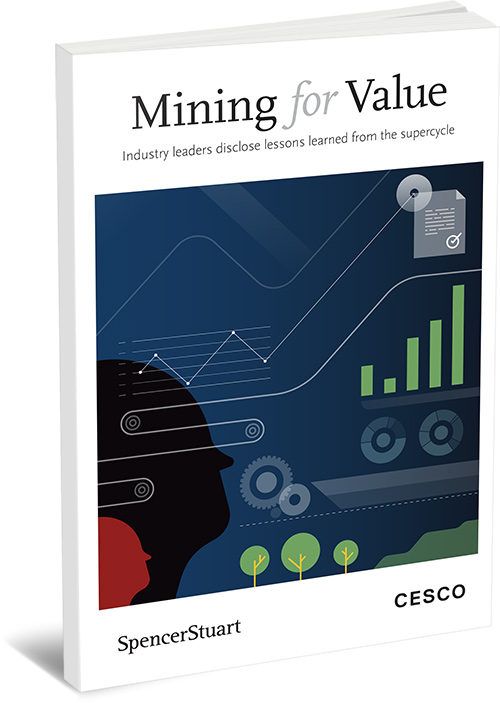Surviving cyclical markets is an inherent challenge for mining companies. The task is made harder by the industry’s need for large upfront capital investments – which take years to pay back – to build new projects and fuel growth. Today’s climate of rapid, intense and global disruptive change adds a new layer of complexity. Mining leaders need to ensure that companies are robust and disciplined but also flexible to manage the ebb and flow of commodity markets and a world in flux.
 The challenge was especially evident during the supercycle that gripped the mining industry during the early years of this century. The period of high prices was unparalleled in its speed, length and strength and, when boom finally turned to bust, many companies were psychologically unprepared and financially overexposed. In our book, Mining for Value, senior figures share their first-hand experiences into what went wrong.
The challenge was especially evident during the supercycle that gripped the mining industry during the early years of this century. The period of high prices was unparalleled in its speed, length and strength and, when boom finally turned to bust, many companies were psychologically unprepared and financially overexposed. In our book, Mining for Value, senior figures share their first-hand experiences into what went wrong.
Their insights show how leadership can avoid repeating history by strengthening internal capacities, improving diversity, and creating receptive cultures to build more resilient and sustainable companies.
Build and retain talent
During the supercycle, the haste to increase production and develop new mines led to a scarcity of available, well-qualified professionals. Companies’ in-house project development and engineering teams had been slashed during a period of low prices at the end of the 1990s, making them heavily dependent on third-party engineering, procurement, construction and management (EPCM) skills. The high demand for human resources often led EPCM contractors to outsource work and take on less experienced people. “B teams” replaced the promised “A teams.”
In addition, weak internal capabilities and inadequate oversight mechanisms sapped project supervision. Capital cost overruns soared by an average of more than 40 percent, projects were severely delayed, and companies ran up huge debts.
To avoid this in the future, leaders should maintain investment in R&D and engineering capabilities through the commodity cycles. The best people need to be in the key roles ready for when a bull market kicks in. This will also drive the industry’s much-needed adoption of innovation and technology.
From an organizational perspective, first-rate “owner’s teams” are required to provide proper oversight of project development.
This should not only be limited to organic growth projects. Leaders need to define and keep control of key tasks across the business. Talent development and retention programs will help companies find, train and keep the right people for the right roles.
Create an attractive culture
A company’s culture is its backbone. A culture that’s aligned with the organizational strategy can drive innovation, growth and market leadership. It can help retain employees when skilled workers are in high demand and provide the conditions to implement transformational change as required. An outdated culture erodes productivity and staff loyalty.
Leadership is inextricably linked with culture; boards need to understand its importance and select CEOs who embrace and embody the necessary culture for their company.
In an era that heralds the fail-fast-and-learn cultures, the mining industry’s seems especially resistant to change — reflected by a slow adoption of innovation and technology. The most recent technological breakthrough was the leach-solvent extraction-electrowinning process widely introduced in the 1980s. Manual labor is often preferred when automated alternatives exist. Likewise, the industry’s self-sufficient nature has hindered it from learning from other sectors.
These characteristics make it harder to attract talent — and threaten the industry’s very survival. It needs to shift towards a more open, learning-oriented culture that will provide it with the agility and skills to fare in today’s more complex and unpredictable environment. Learning cultures promote innovation and knowledge, express curiosity and openness, and accept that change is inevitable.
Improve diversity
The mining industry draws its skills from a narrow pool of mainly male engineering and business graduates. It desperately needs to increase diversity of aptitudes, gender, nationalities and cultures to help solve long-standing problems such as environmental impacts. Start-up mentalities and flexible mindsets will spur innovation.
For example, on average women make up around 10 percent of the mining workforce globally according to PwC and Women in Mining UK. Yet McKinsey found that companies in the top quartile for gender diversity were 15 percent more likely to have financial returns above their respective national industry medians. According to global diversified miner BHP, operations with higher female participation had lower injury rates, adhered more closely to work plans, and were more likely to meet production targets.
Efforts are being made to redress the gender imbalance. BHP has committed to women making up half of their workforce by 2025. Rio Tinto aims for 50 percent of graduate hires to be women. Others have signed up to the 30% Club goal of achieving a minimum 30 percent female representation on boards and executive committees.
Management also need to advocate the importance of diversity to propel change. Recruitment efforts must remove unconscious bias by making sure that multiple female and diverse candidates are short-listed, using gender-neutral language, and offering flexible work schedules for all.
By focusing on talent, culture, and diversity, leaders can prepare mining companies to withstand volatile commodity markets and a changing world.